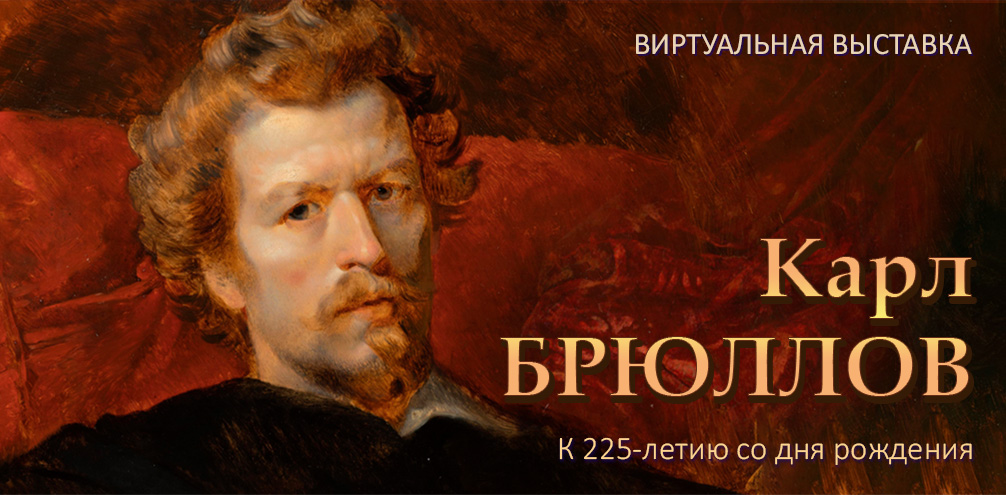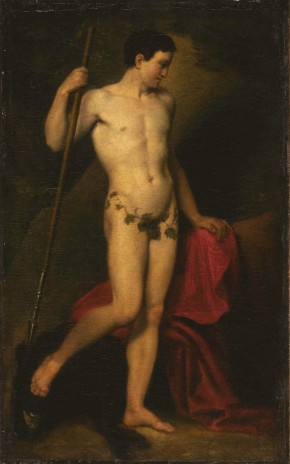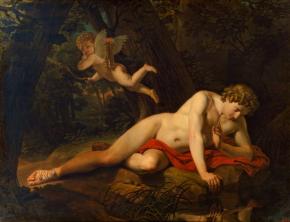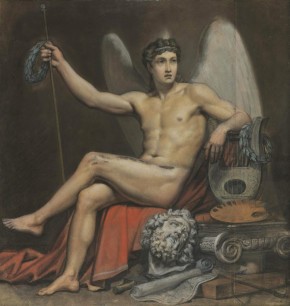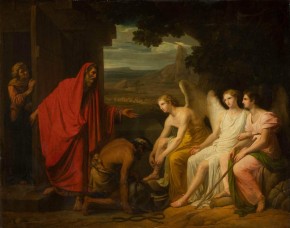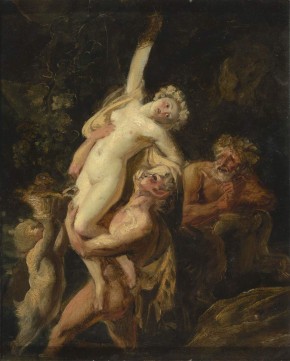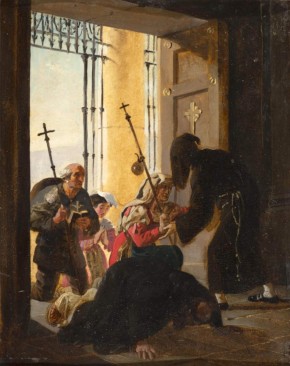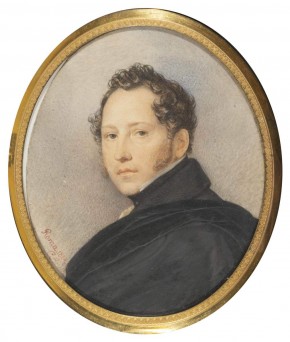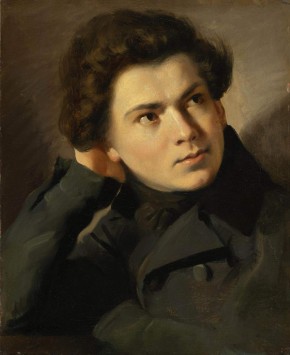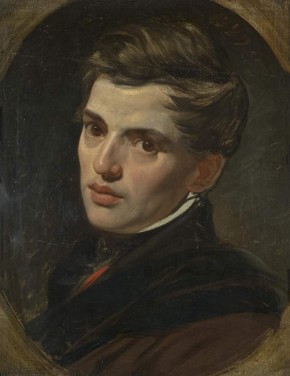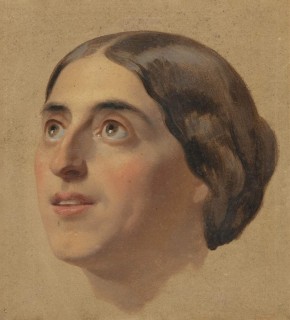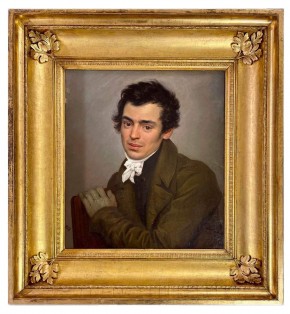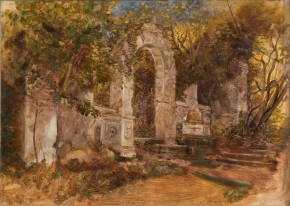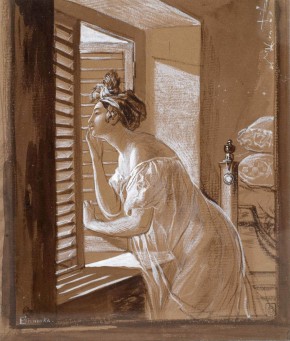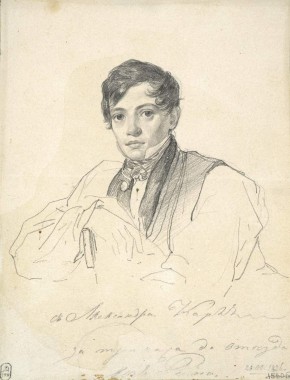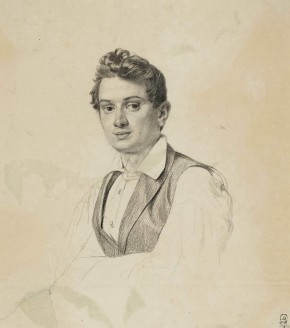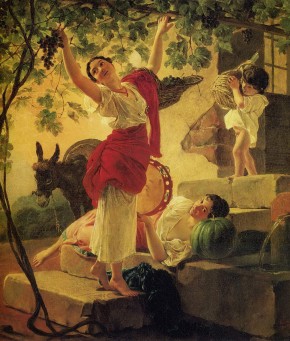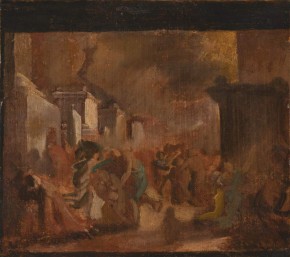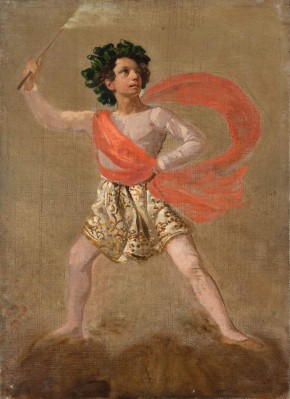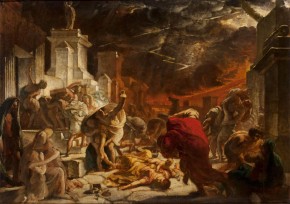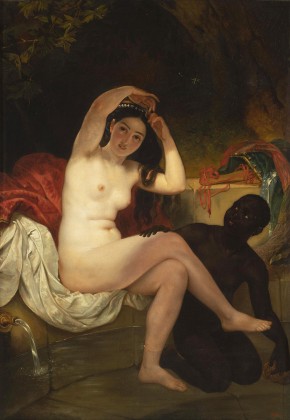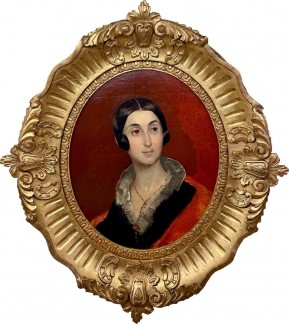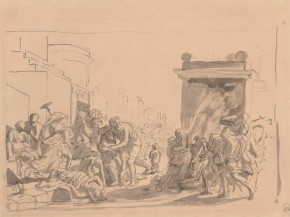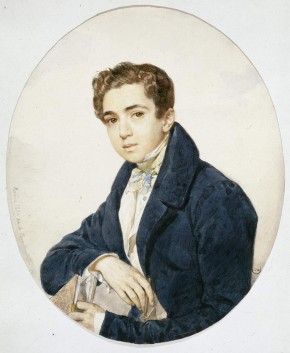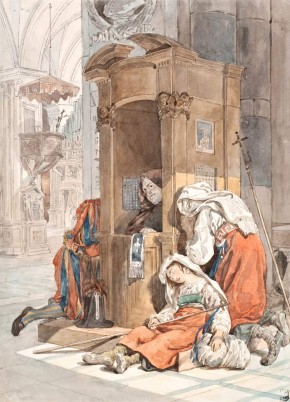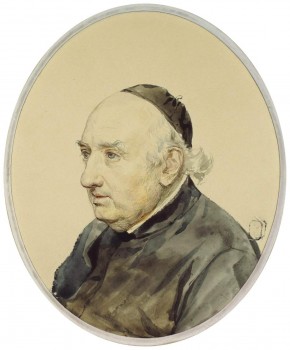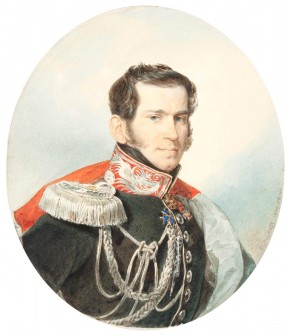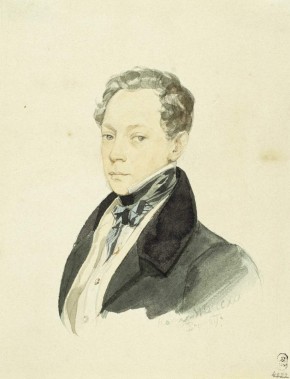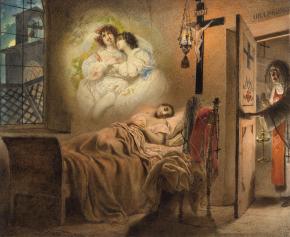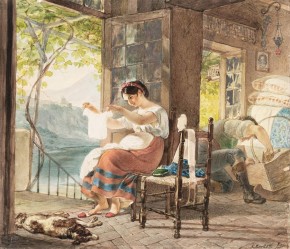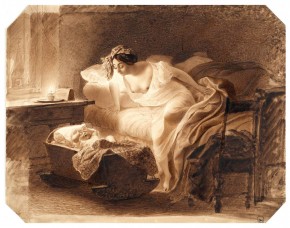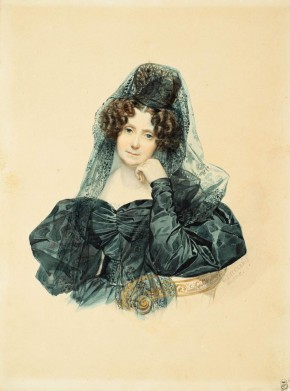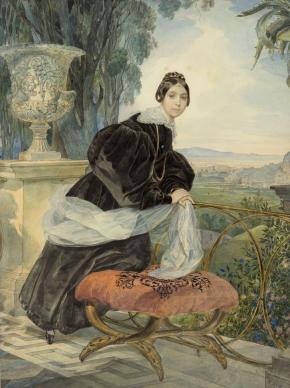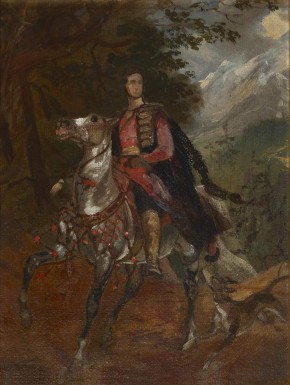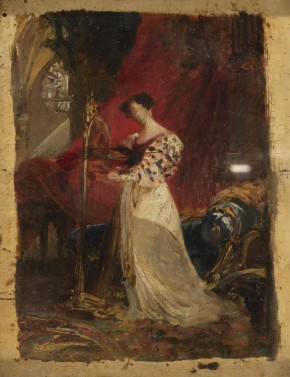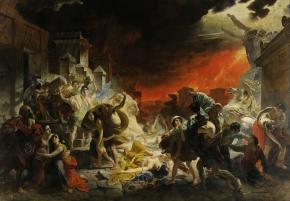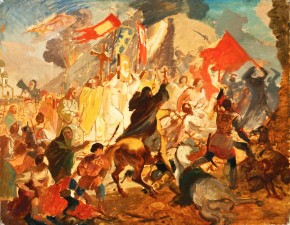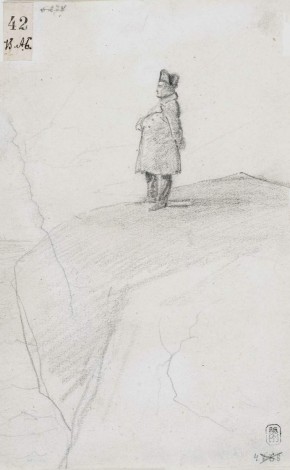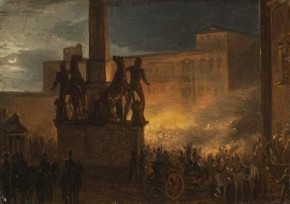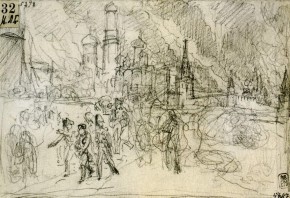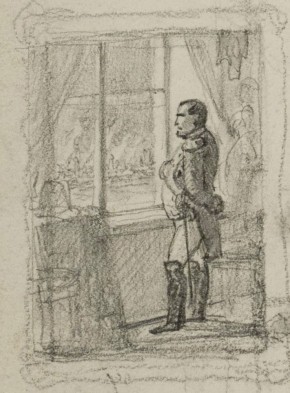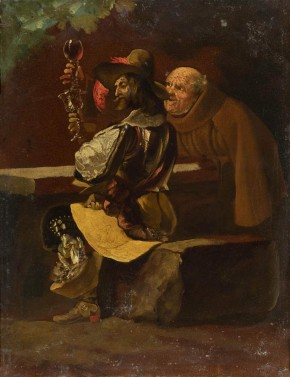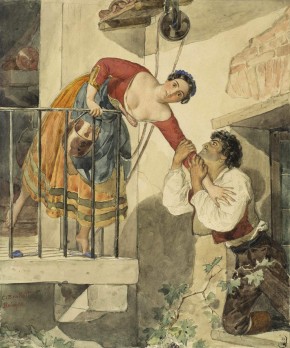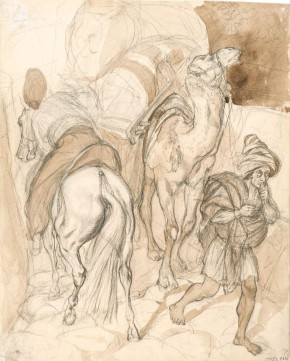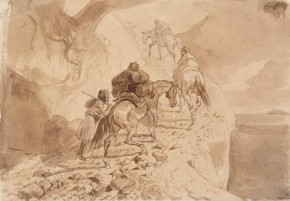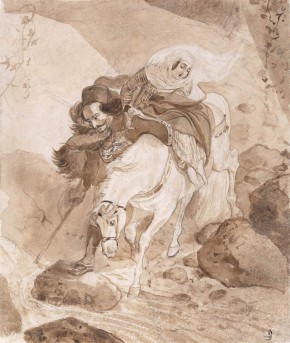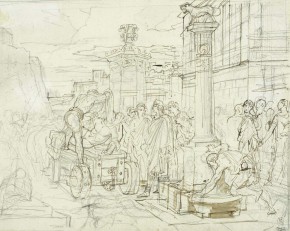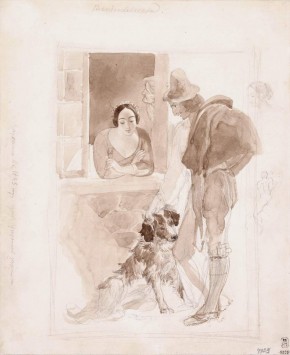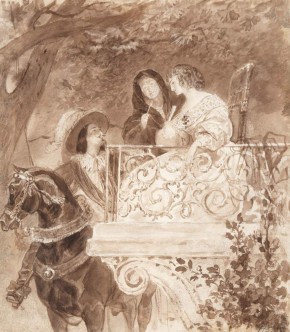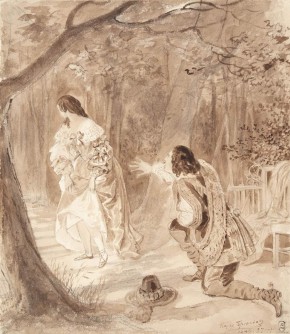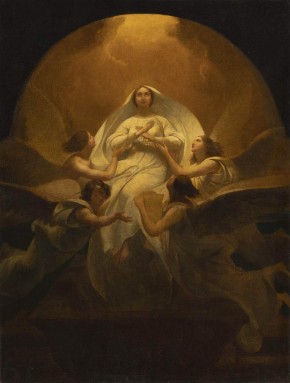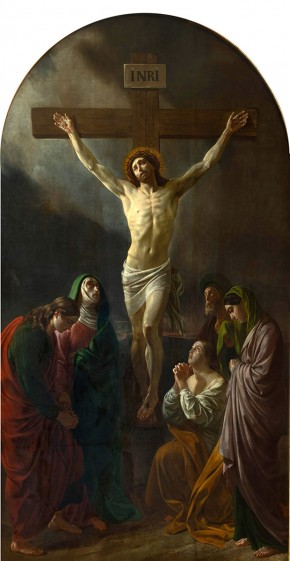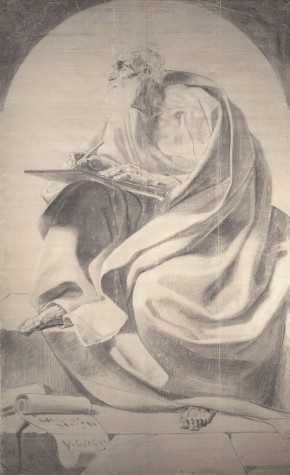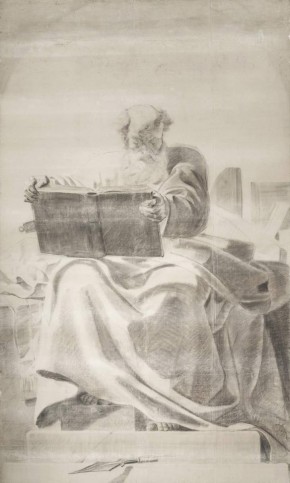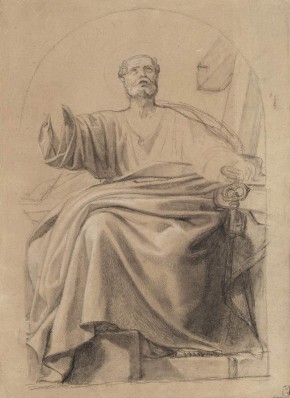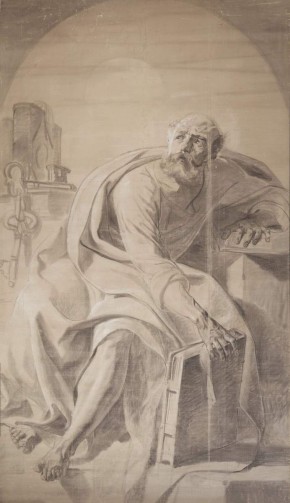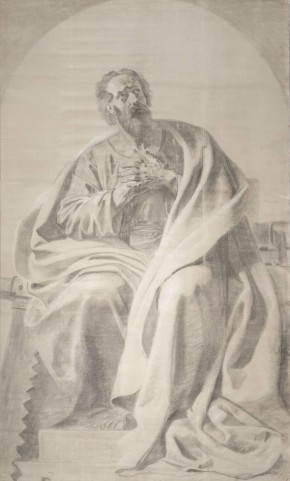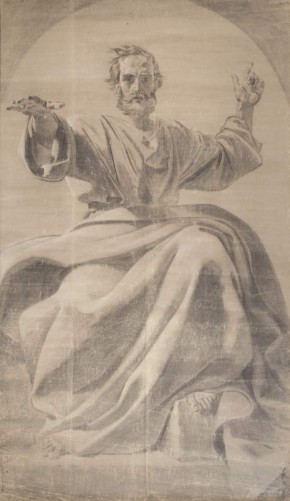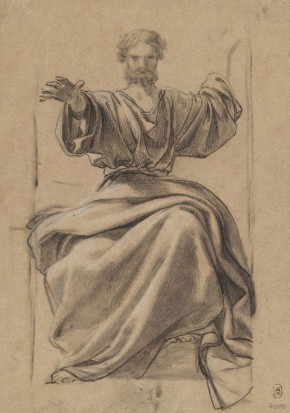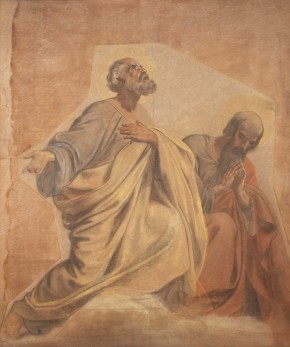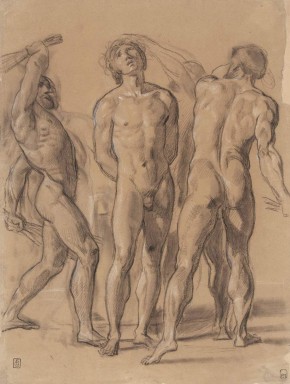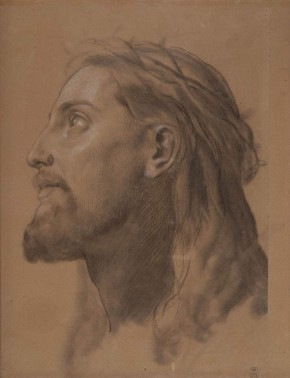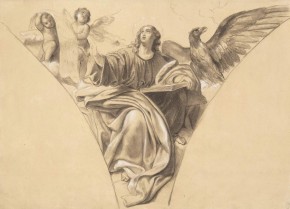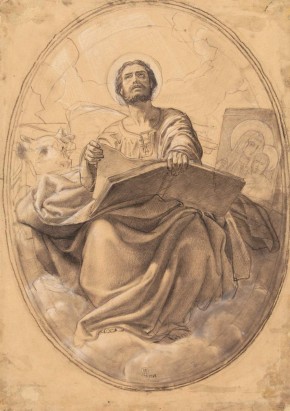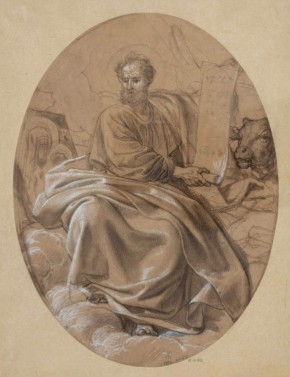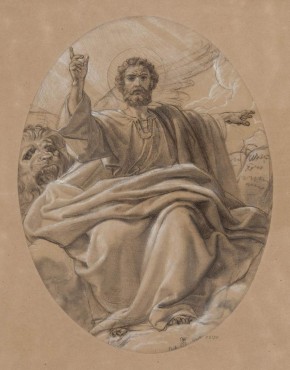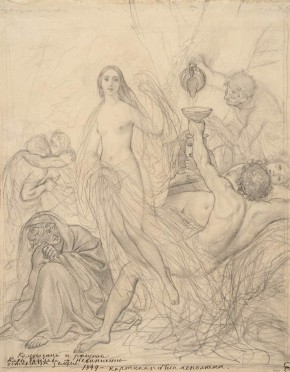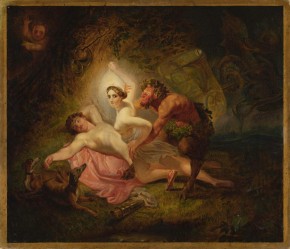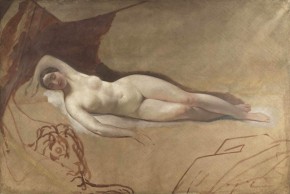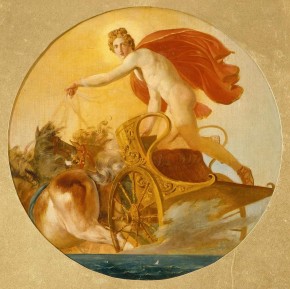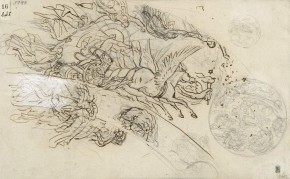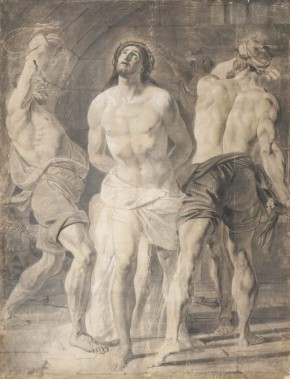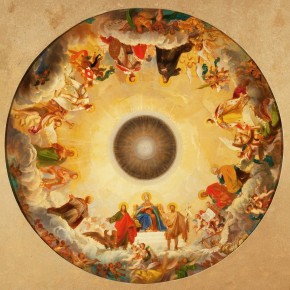Advanced search collections
Обнаженный юноша с копьем
- 1810s
- Canvas, oil. 56 х 34
- The State Russian Museum
- Ж-6296
Narcissus, Looking into the Water
- 1918
- Canvas, oil. 162 x 209,5
- The State Russian Museum
- Ж-5074
The subject is taken from the third book of Ovid's “Metamorphoses”. Narcissus, a handsome young man from Festia or Lacedaemon, was the son of the nymph Liriope and Cephissus. It was predicted to his mother that he would live to a great age, if he did not see his own face. As a boy Narcissus often hunted in the woods. On one hot afternoon, weary from the heat, Narcissus bent over the source to quench his thirst and saw his face. According to Ovid: “While he is drinking he beholds himself reflected in the mirrored pool — and loves...” Having forgotten about sleep and food, Narcissus, who had never loved anyone, spent days and nights on the shore, admiring his reflection, and died of sorrow. The gods turned him into a flower, which became known as a Narcissus.
This painting is recognized as one of the best K.P. Brullov’s works of the period of his studies at the Academy of Arts. In 1819, in the class of Andrey Ivanov a male figure was "presented" as a task for painters – a figure of a reclining young man, leaning over the water. According to the memoirs of contemporaries, the artist painted the landscape background in the Park of the Stroganovs’ dacha on the Chernaya river. In 1819 for this painting Brullov received a gold medal of the second rank.
"Metamorphoses" (Lat.) – a poem by the Roman poet Ovid consisting of fifteen books, which focuses on various transformations that have occurred since the creation of the world, according to Greek and Roman mythologies. The poem was written by Ovid in Rome between 2 and 8 years A.D.
Perseus and Andromeda
- Study (?)
- 1810s
- Canvas, oil. 43,7 х 28,6
- The State Russian Museum
- Ж-3361
Гений искусств
- 1819–1821
- Paper, pastel, сharcoal , chalk. 65,2 x 62,2
- The State Russian Museum
- Р-38934
Abraham’s Vision of God in the Form of Three Angels at the Oaks of Mamre
- 1821
- Canvas, oil. 113 х 144
- The State Russian Museum
- Ж-5075
Вакхическая группа
- 1824
- Canvas, oil. 25,5 x 21
- The State Russian Museum
- Ж-3360
Пилигримы в дверях храма
- Paper, oil. 20,4 x 16,2
- The State Russian Museum
- Ж-3355
Портрет С. Ф. Щедрина
- 1824
- Cardboard, watercolour.
- The State Russian Museum
- Р-8435
Portrait of a Young Man
- 1820s
- Canvas, oil. 43,5 x 35
- The State Russian Museum
- Ж-5076
Portrait of the Artist’s Elder Brother, the Architect and Painter Alexander Brullov
- Canvas, oil.
- The State Russian Museum
- Ж-5080
Голова натурщицы
- 1820s
- paper mounted on canvas, oil. 17,2 х 17,2
- The State Russian Museum
- Ж-11809
Портрет архитектора К. А. Тона
- 1820s
- Canvas, oil. 56,5 х 51
- The State Russian Museum
- Ж-5099
Руины в парке
- 1820s
- Cardboard, oil. 29 х 40,5
- The State Russian Museum
- Ж-3366
Беседа Нумы Помпилия с нимфой Эгерией
- Paper, oil. 28,5 х 36
- The State Russian Museum
- Ж-3367
Женщина, посылающая поцелуй из окна
- 1826
- Sepia, white pigment. 21,7 х 18,4
- The State Russian Museum
- Р-2264
Портрет А. П. Брюллова
- 1826
- Paper, graphite pencil. 18,6 х 14,2
- The State Russian Museum
- Р-13105
Портрет А. П. Брюллова
- 1826
- Paper, italian pencil. 24,8 х 22
- The State Russian Museum
- Р-2257
A Girl Picking Grapes in the Environs of Naples
- 1827
- Canvas, oil. 62 x 52,5
- The State Russian Museum
- Ж-5078
Portrait of K. A. and M. Y. Naryshkins
- 1827
- Paper, watercolour, white pigment, graphite pencil. 46 х 36,5
- The State Russian Museum
- Р-13101
Together with count M. D. Nesselrode, prince A. N. Golitsyn and F. I. Samarin, K. A. Naryshkin was among the customers of K. P. Brullov, about which the artist reported to the Society for the Encouragement of Artists in July 1825.
Naryshkin Kirill Aleksandrovich (1786–1838) — chief marshal of the court. In 1805 visited China together with the embassy of the count Y. A. Golovkin. Chamberlain (1826), the marshal and the president of the Court office, since 1834 — chief marshal of the court. In 1834 was appointed member of the State Council. Member of the Society for the Encouragement of Artists (1822).
Naryshkina Maria Yakovlevna (1789–1854), née princess Lobanova-Rostovskaya, wife of K. A. Naryshkin.
Последний день Помпеи
- 1827–1828
- paper mounted on cardboard, oil. 17,5 x 19,7
- The State Russian Museum
- Ж-7867
Brullov (Bruleau) Karl Pavlovich
1799, St Petersburg -1852, Manziana (near Rome)Painter, watercolourist, draughtsman, history painter, portraitist, genre painter, mural painter. Born into an artistic family. Studied under Anton Ivanov, Alexei Yegorov and Vasily Shebuyev at the Imperial Academy of Arts (1809-22), graduated with a first-class gold medal. Sent to Italy by the Society for the Encouragement of Arts (1822-35). Worked in Milan, Naples and Rome. Won fame in Europe as a portraitist and history painter for such works as The Last Day of Pompeii (1827-33, Russian Museum. St Petersburg)- Returned to Russia and lived in St Petersburg. Honorary freeman (1834), second-degree professor (1835) and first-degree professor (1846) of the Imperial Academy of Arts, where he taught history painting, enjoying the love and respect of his many students. Professor of the Accademia di Belle Arti in Florence. Contributed to exhibitions in Rome, Milan, Paris and St Petersburg. Went abroad on the advice of doctors (1849), settled in Italy (1850).
Обнаженный юноша с копьем
- 1810s
- Canvas, oil. 56 х 34
- The State Russian Museum
- Ж-6296
Narcissus, Looking into the Water
- 1918
- Canvas, oil. 162 x 209,5
- The State Russian Museum
- Ж-5074
The subject is taken from the third book of Ovid's “Metamorphoses”. Narcissus, a handsome young man from Festia or Lacedaemon, was the son of the nymph Liriope and Cephissus. It was predicted to his mother that he would live to a great age, if he did not see his own face. As a boy Narcissus often hunted in the woods. On one hot afternoon, weary from the heat, Narcissus bent over the source to quench his thirst and saw his face. According to Ovid: “While he is drinking he beholds himself reflected in the mirrored pool — and loves...” Having forgotten about sleep and food, Narcissus, who had never loved anyone, spent days and nights on the shore, admiring his reflection, and died of sorrow. The gods turned him into a flower, which became known as a Narcissus.
This painting is recognized as one of the best K.P. Brullov’s works of the period of his studies at the Academy of Arts. In 1819, in the class of Andrey Ivanov a male figure was "presented" as a task for painters – a figure of a reclining young man, leaning over the water. According to the memoirs of contemporaries, the artist painted the landscape background in the Park of the Stroganovs’ dacha on the Chernaya river. In 1819 for this painting Brullov received a gold medal of the second rank.
"Metamorphoses" (Lat.) – a poem by the Roman poet Ovid consisting of fifteen books, which focuses on various transformations that have occurred since the creation of the world, according to Greek and Roman mythologies. The poem was written by Ovid in Rome between 2 and 8 years A.D.
Perseus and Andromeda
- Study (?)
- 1810s
- Canvas, oil. 43,7 х 28,6
- The State Russian Museum
- Ж-3361
Abraham’s Vision of God in the Form of Three Angels at the Oaks of Mamre
- 1821
- Canvas, oil. 113 х 144
- The State Russian Museum
- Ж-5075
Вакхическая группа
- 1824
- Canvas, oil. 25,5 x 21
- The State Russian Museum
- Ж-3360
Пилигримы в дверях храма
- Paper, oil. 20,4 x 16,2
- The State Russian Museum
- Ж-3355
Portrait of a Young Man
- 1820s
- Canvas, oil. 43,5 x 35
- The State Russian Museum
- Ж-5076
Portrait of the Artist’s Elder Brother, the Architect and Painter Alexander Brullov
- Canvas, oil.
- The State Russian Museum
- Ж-5080
Голова натурщицы
- 1820s
- paper mounted on canvas, oil. 17,2 х 17,2
- The State Russian Museum
- Ж-11809
Портрет архитектора К. А. Тона
- 1820s
- Canvas, oil. 56,5 х 51
- The State Russian Museum
- Ж-5099
Руины в парке
- 1820s
- Cardboard, oil. 29 х 40,5
- The State Russian Museum
- Ж-3366
Беседа Нумы Помпилия с нимфой Эгерией
- Paper, oil. 28,5 х 36
- The State Russian Museum
- Ж-3367
A Girl Picking Grapes in the Environs of Naples
- 1827
- Canvas, oil. 62 x 52,5
- The State Russian Museum
- Ж-5078
Последний день Помпеи
- 1827–1828
- paper mounted on cardboard, oil. 17,5 x 19,7
- The State Russian Museum
- Ж-7867
Вольтижер
- Canvas, oil. 43 х 30
- The State Russian Museum
- Ж-3362
Последний день Помпеи
- 1828
- paper mounted on cardboard, oil. 58 x 81
- The State Russian Museum
- Ж-5081
Bathsheba
- Version of Bathsheba (1832, Tret. Gal.)
- 1830s (?)
- Canvas, oil. 87,5 х 61,5
- The State Russian Museum
- Ж-5083
According to the Bible, Bathsheba was the wife of King David. Bathsheba is generally depicted in art next to a spring, attended by a maid and a negro boy. This was a subject highly popular in European painting as a specific hymn of praise to female beauty and this is how it was painted by Brullov. The artist, however, also interprets the biblical scene in the spirit of the "Italian genre", which was popular in Russian art in the 1840s. The canvas appears to have been painted in the early 1830s in Italy. A large unfinished picture by Brullov on the same subject hangs in the State Tretyakov Gallery in Moscow.
Portrait of Elena Ton, Wife of the Architect Konstantin Ton
- Canvas, oil.
- The State Russian Museum
- Ж-5094
Portrait of Grand Duchess Elena Pavlovna, née Princess Friederike Charlotte of Württemberg, Wife of Grand Duke Mikhail Pavlovich, with her Daughter Grand Duchess Maria Mikhailovna
- 1830
- Canvas, oil. 265 x 185
- The State Russian Museum
- Ж-5082
Grand Duchess Elena Pavlovna (1806–1873), born Princess Friederike Charlotte Marie of Württemberg, became the wife of Grand Duke Michael Pavlovich in 1824. She was educated in Paris at a private boarding school. She was famous for her charity work. During the Crimean War, she organised the Holy Cross Fellowship of Sisters of Mercy, which would become the prototype for the Red Cross. She was a patroness of composers, musicians, writers, and scientists. In 1858, she began the first conservatory classes led by composer and conductor Anton Rubinstein at her home in the Mikhailovsky Palace. She was one of the founders of the Russian Musical Society (1859). She was a strong supporter of liberal reforms and contributed to the liberation of peasants from serfdom.
Portrait of the Archbishop and Writer Giuseppe Capecelatro
- Canvas, oil.
- The State Russian Museum
- Ж-5101
Гений искусств
- 1819–1821
- Paper, pastel, сharcoal , chalk. 65,2 x 62,2
- The State Russian Museum
- Р-38934
Портрет С. Ф. Щедрина
- 1824
- Cardboard, watercolour.
- The State Russian Museum
- Р-8435
Женщина, посылающая поцелуй из окна
- 1826
- Sepia, white pigment. 21,7 х 18,4
- The State Russian Museum
- Р-2264
Портрет А. П. Брюллова
- 1826
- Paper, italian pencil. 24,8 х 22
- The State Russian Museum
- Р-2257
Портрет А. П. Брюллова
- 1826
- Paper, graphite pencil. 18,6 х 14,2
- The State Russian Museum
- Р-13105
Portrait of K. A. and M. Y. Naryshkins
- 1827
- Paper, watercolour, white pigment, graphite pencil. 46 х 36,5
- The State Russian Museum
- Р-13101
Together with count M. D. Nesselrode, prince A. N. Golitsyn and F. I. Samarin, K. A. Naryshkin was among the customers of K. P. Brullov, about which the artist reported to the Society for the Encouragement of Artists in July 1825.
Naryshkin Kirill Aleksandrovich (1786–1838) — chief marshal of the court. In 1805 visited China together with the embassy of the count Y. A. Golovkin. Chamberlain (1826), the marshal and the president of the Court office, since 1834 — chief marshal of the court. In 1834 was appointed member of the State Council. Member of the Society for the Encouragement of Artists (1822).
Naryshkina Maria Yakovlevna (1789–1854), née princess Lobanova-Rostovskaya, wife of K. A. Naryshkin.
Последний день Помпеи
- 1828 (?)
- Ink, brush, nib. 22, 8 х 30
- The State Russian Museum
- Р-13109
Портрет князя Г. Г. Гагарина
- 1829
- Paper, watercolour, graphite pencil.
- The State Russian Museum
- Р-2228
Dream of a Grandmother and Granddaughter
- 1829
- Paper, watercolour, bronze, varnish. 22,5 x 27,4
- The State Russian Museum
- Р-2275
Dream of a Grandmother and Granddaughter is a humorous and ironic disclosure of the secret thoughts and dreams that people take great pains to hide in daily life. The light frivolity and erotica typical of many of Brullov’s works permeate the dreams of the two heroines of this watercolour. Russian Museum: From Icons to the Modern Times. Palace Editions, St Petersburg, 2015. P. 124.
На исповеди
- 1827–1831
- Paper, watercolour, graphite pencil, varnish. 26,2 х 18,7
- The State Russian Museum
- Р-2231
Портрет патера Рикка деи Сколопи из колледжа Толомеи в Сиене
- 1829 (?)
- Watercolour.
- The State Russian Museum
- Р-2268
Портрет флигель-адъютанта графа А. Г. Строганова
- 1829
- Paper, watercolour, varnish.
- The State Russian Museum
- Р-2267
Портрет П. В. Басина
- 1830
- Paper, watercolour, graphite pencil. 19 х 15
- The State Russian Museum
- Р-2206
Nun’s Dream
- 1831
- Cardboard, watercolour, graphite pencil, varnish. 22,5 х 27,4
- The State Russian Museum
- Р-2175
Masterfully executed by the artist genre scenes were extremely popular in their time. People found in them exploration of new themes, freedom from conventions, and luxury of craftsmanship. It is the precise watercolour and sepia technique itself that attracts in them.
Looking for the new, unusual, attractive, and sometimes "enticing", Brullov was often balancing on the verge of good taste. In his legacy there are works ("Grandmother and Granddaughter’s Dream", "Dream of a Nun" and others), funny and entertaining in their openness and amazing due to fantastic craftsmanship of Brullov-watercolourist.
This is the kind of watercolour works by Brullov, which, along with some of his paintings, served to spread salon creations in art. The artist turned out to have a lot of imitators, varying or slightly modifying themes opened by him, his graphic methods. Humorous genres of Brullov enriched the entire industry of salon art, although perhaps did not belong to it themselves.
Автопортрет
- 1830–1833
- Watercolour, graphite pencil. 26,6 х 22,5
- The State Russian Museum
- Р-2225
Итальянская семья (В ожидании ребенка)
- 1831
- Watercolour, varnish. 18,8 х 22,4
- The State Russian Museum
- Р-13103
Мать, просыпающаяся от плача ребенка
- 1831
- Sepia, varnish.
- The State Russian Museum
- Р-2210
Портрет С. А. Соболевского
- 1832
- Paper, watercolour. 21,5 х 19,5
- The State Russian Museum
- Р-2285
Портрет неизвестной
- 1832
- Watercolour, , graphite pencil, varnish. 33,6 х 25,4
- The State Russian Museum
- Р-2230
Portrait of Her Highness Princess E.P. Saltykova
- 1833–1835
- Cardboard, watercolour, graphite pencil, ink, nib. 44,4 x 33
- The State Russian Museum
- Р-13100
A typical example of the common in the first half of the 19th century commissioned portrait, executed in the finest watercolour technique, in which Karl Brullov was so brilliant.
Her Highness Princess Elizaveta Pavlovna Saltykova (née countess Stroganova; 1802–1863) — the daughter of the adjutant general P. A. Stroganov (1774–1817) and his wife Sophia Vladimirovna (nee Galitsyna; 1775–1845), elder sister of countess O. P. Fersen. Was married to His Highness Prince I.D. Saltykov (1797–1832).
Обнаженный юноша с копьем
- 1810s
- Canvas, oil. 56 х 34
- The State Russian Museum
- Ж-6296
Narcissus, Looking into the Water
- 1918
- Canvas, oil. 162 x 209,5
- The State Russian Museum
- Ж-5074
The subject is taken from the third book of Ovid's “Metamorphoses”. Narcissus, a handsome young man from Festia or Lacedaemon, was the son of the nymph Liriope and Cephissus. It was predicted to his mother that he would live to a great age, if he did not see his own face. As a boy Narcissus often hunted in the woods. On one hot afternoon, weary from the heat, Narcissus bent over the source to quench his thirst and saw his face. According to Ovid: “While he is drinking he beholds himself reflected in the mirrored pool — and loves...” Having forgotten about sleep and food, Narcissus, who had never loved anyone, spent days and nights on the shore, admiring his reflection, and died of sorrow. The gods turned him into a flower, which became known as a Narcissus.
This painting is recognized as one of the best K.P. Brullov’s works of the period of his studies at the Academy of Arts. In 1819, in the class of Andrey Ivanov a male figure was "presented" as a task for painters – a figure of a reclining young man, leaning over the water. According to the memoirs of contemporaries, the artist painted the landscape background in the Park of the Stroganovs’ dacha on the Chernaya river. In 1819 for this painting Brullov received a gold medal of the second rank.
"Metamorphoses" (Lat.) – a poem by the Roman poet Ovid consisting of fifteen books, which focuses on various transformations that have occurred since the creation of the world, according to Greek and Roman mythologies. The poem was written by Ovid in Rome between 2 and 8 years A.D.
Perseus and Andromeda
- Study (?)
- 1810s
- Canvas, oil. 43,7 х 28,6
- The State Russian Museum
- Ж-3361
Гений искусств
- 1819–1821
- Paper, pastel, сharcoal , chalk. 65,2 x 62,2
- The State Russian Museum
- Р-38934
Abraham’s Vision of God in the Form of Three Angels at the Oaks of Mamre
- 1821
- Canvas, oil. 113 х 144
- The State Russian Museum
- Ж-5075
Голова натурщицы
- 1820s
- paper mounted on canvas, oil. 17,2 х 17,2
- The State Russian Museum
- Ж-11809
Руины в парке
- 1820s
- Cardboard, oil. 29 х 40,5
- The State Russian Museum
- Ж-3366
Вакхическая группа
- 1824
- Canvas, oil. 25,5 x 21
- The State Russian Museum
- Ж-3360
Пилигримы в дверях храма
- Paper, oil. 20,4 x 16,2
- The State Russian Museum
- Ж-3355
Портрет С. Ф. Щедрина
- 1824
- Cardboard, watercolour.
- The State Russian Museum
- Р-8435
Portrait of a Young Man
- 1820s
- Canvas, oil. 43,5 x 35
- The State Russian Museum
- Ж-5076
Portrait of the Artist’s Elder Brother, the Architect and Painter Alexander Brullov
- Canvas, oil.
- The State Russian Museum
- Ж-5080
Беседа Нумы Помпилия с нимфой Эгерией
- Paper, oil. 28,5 х 36
- The State Russian Museum
- Ж-3367
Женщина, посылающая поцелуй из окна
- 1826
- Sepia, white pigment. 21,7 х 18,4
- The State Russian Museum
- Р-2264
Портрет А. П. Брюллова
- 1826
- Paper, graphite pencil. 18,6 х 14,2
- The State Russian Museum
- Р-13105
Портрет А. П. Брюллова
- 1826
- Paper, italian pencil. 24,8 х 22
- The State Russian Museum
- Р-2257
A Girl Picking Grapes in the Environs of Naples
- 1827
- Canvas, oil. 62 x 52,5
- The State Russian Museum
- Ж-5078
Последний день Помпеи
- 1827–1828
- paper mounted on cardboard, oil. 17,5 x 19,7
- The State Russian Museum
- Ж-7867
Вольтижер
- Canvas, oil. 43 х 30
- The State Russian Museum
- Ж-3362
Последний день Помпеи
- 1828
- paper mounted on cardboard, oil. 58 x 81
- The State Russian Museum
- Ж-5081
Портрет князя Г. Г. Гагарина
- 1829
- Paper, watercolour, graphite pencil.
- The State Russian Museum
- Р-2228
Dream of a Grandmother and Granddaughter
- 1829
- Paper, watercolour, bronze, varnish. 22,5 x 27,4
- The State Russian Museum
- Р-2275
Dream of a Grandmother and Granddaughter is a humorous and ironic disclosure of the secret thoughts and dreams that people take great pains to hide in daily life. The light frivolity and erotica typical of many of Brullov’s works permeate the dreams of the two heroines of this watercolour. Russian Museum: From Icons to the Modern Times. Palace Editions, St Petersburg, 2015. P. 124.
На исповеди
- 1827–1831
- Paper, watercolour, graphite pencil, varnish. 26,2 х 18,7
- The State Russian Museum
- Р-2231
Портрет патера Рикка деи Сколопи из колледжа Толомеи в Сиене
- 1829 (?)
- Watercolour.
- The State Russian Museum
- Р-2268
Портрет флигель-адъютанта графа А. Г. Строганова
- 1829
- Paper, watercolour, varnish.
- The State Russian Museum
- Р-2267
Bathsheba
- Version of Bathsheba (1832, Tret. Gal.)
- 1830s (?)
- Canvas, oil. 87,5 х 61,5
- The State Russian Museum
- Ж-5083
According to the Bible, Bathsheba was the wife of King David. Bathsheba is generally depicted in art next to a spring, attended by a maid and a negro boy. This was a subject highly popular in European painting as a specific hymn of praise to female beauty and this is how it was painted by Brullov. The artist, however, also interprets the biblical scene in the spirit of the "Italian genre", which was popular in Russian art in the 1840s. The canvas appears to have been painted in the early 1830s in Italy. A large unfinished picture by Brullov on the same subject hangs in the State Tretyakov Gallery in Moscow.
Portrait of Grand Duchess Elena Pavlovna, née Princess Friederike Charlotte of Württemberg, Wife of Grand Duke Mikhail Pavlovich, with her Daughter Grand Duchess Maria Mikhailovna
- 1830
- Canvas, oil. 265 x 185
- The State Russian Museum
- Ж-5082
Grand Duchess Elena Pavlovna (1806–1873), born Princess Friederike Charlotte Marie of Württemberg, became the wife of Grand Duke Michael Pavlovich in 1824. She was educated in Paris at a private boarding school. She was famous for her charity work. During the Crimean War, she organised the Holy Cross Fellowship of Sisters of Mercy, which would become the prototype for the Red Cross. She was a patroness of composers, musicians, writers, and scientists. In 1858, she began the first conservatory classes led by composer and conductor Anton Rubinstein at her home in the Mikhailovsky Palace. She was one of the founders of the Russian Musical Society (1859). She was a strong supporter of liberal reforms and contributed to the liberation of peasants from serfdom.
Портрет С. Ф. Щедрина
- 1824
- Cardboard, watercolour.
- The State Russian Museum
- Р-8435
Portrait of a Young Man
- 1820s
- Canvas, oil. 43,5 x 35
- The State Russian Museum
- Ж-5076
Portrait of the Artist’s Elder Brother, the Architect and Painter Alexander Brullov
- Canvas, oil.
- The State Russian Museum
- Ж-5080
Голова натурщицы
- 1820s
- paper mounted on canvas, oil. 17,2 х 17,2
- The State Russian Museum
- Ж-11809
Портрет архитектора К. А. Тона
- 1820s
- Canvas, oil. 56,5 х 51
- The State Russian Museum
- Ж-5099
Портрет А. П. Брюллова
- 1826
- Paper, italian pencil. 24,8 х 22
- The State Russian Museum
- Р-2257
Портрет А. П. Брюллова
- 1826
- Paper, graphite pencil. 18,6 х 14,2
- The State Russian Museum
- Р-13105
Portrait of K. A. and M. Y. Naryshkins
- 1827
- Paper, watercolour, white pigment, graphite pencil. 46 х 36,5
- The State Russian Museum
- Р-13101
Together with count M. D. Nesselrode, prince A. N. Golitsyn and F. I. Samarin, K. A. Naryshkin was among the customers of K. P. Brullov, about which the artist reported to the Society for the Encouragement of Artists in July 1825.
Naryshkin Kirill Aleksandrovich (1786–1838) — chief marshal of the court. In 1805 visited China together with the embassy of the count Y. A. Golovkin. Chamberlain (1826), the marshal and the president of the Court office, since 1834 — chief marshal of the court. In 1834 was appointed member of the State Council. Member of the Society for the Encouragement of Artists (1822).
Naryshkina Maria Yakovlevna (1789–1854), née princess Lobanova-Rostovskaya, wife of K. A. Naryshkin.
Портрет князя Г. Г. Гагарина
- 1829
- Paper, watercolour, graphite pencil.
- The State Russian Museum
- Р-2228
Портрет патера Рикка деи Сколопи из колледжа Толомеи в Сиене
- 1829 (?)
- Watercolour.
- The State Russian Museum
- Р-2268
Портрет флигель-адъютанта графа А. Г. Строганова
- 1829
- Paper, watercolour, varnish.
- The State Russian Museum
- Р-2267
Portrait of Elena Ton, Wife of the Architect Konstantin Ton
- Canvas, oil.
- The State Russian Museum
- Ж-5094
Portrait of Grand Duchess Elena Pavlovna, née Princess Friederike Charlotte of Württemberg, Wife of Grand Duke Mikhail Pavlovich, with her Daughter Grand Duchess Maria Mikhailovna
- 1830
- Canvas, oil. 265 x 185
- The State Russian Museum
- Ж-5082
Grand Duchess Elena Pavlovna (1806–1873), born Princess Friederike Charlotte Marie of Württemberg, became the wife of Grand Duke Michael Pavlovich in 1824. She was educated in Paris at a private boarding school. She was famous for her charity work. During the Crimean War, she organised the Holy Cross Fellowship of Sisters of Mercy, which would become the prototype for the Red Cross. She was a patroness of composers, musicians, writers, and scientists. In 1858, she began the first conservatory classes led by composer and conductor Anton Rubinstein at her home in the Mikhailovsky Palace. She was one of the founders of the Russian Musical Society (1859). She was a strong supporter of liberal reforms and contributed to the liberation of peasants from serfdom.
Portrait of the Archbishop and Writer Giuseppe Capecelatro
- Canvas, oil.
- The State Russian Museum
- Ж-5101
Портрет П. В. Басина
- 1830
- Paper, watercolour, graphite pencil. 19 х 15
- The State Russian Museum
- Р-2206
Автопортрет
- 1830–1833
- Watercolour, graphite pencil. 26,6 х 22,5
- The State Russian Museum
- Р-2225
Портрет А. Н. Демидова, князя Сан-Донато
- Canvas, oil. 28 x 21,3
- The State Russian Museum
- Ж-3363
Портрет С. А. Соболевского
- 1832
- Paper, watercolour. 21,5 х 19,5
- The State Russian Museum
- Р-2285
Портрет неизвестной
- 1832
- Watercolour, , graphite pencil, varnish. 33,6 х 25,4
- The State Russian Museum
- Р-2230
Портрет неизвестной, играющей на арфе
- Wood, oil. 18,9 х 14,7
- The State Russian Museum
- Ж-3357
Последний день Помпеи
- 1827–1828
- paper mounted on cardboard, oil. 17,5 x 19,7
- The State Russian Museum
- Ж-7867
Последний день Помпеи
- 1828
- paper mounted on cardboard, oil. 58 x 81
- The State Russian Museum
- Ж-5081
Последний день Помпеи
- 1828 (?)
- Ink, brush, nib. 22, 8 х 30
- The State Russian Museum
- Р-13109
The Last Day of Pompeii
- 1833
- Canvas, oil. 456,5 x 651
- The State Russian Museum
- Ж-5084
The subject of the canvas is the destruction of the ancient Roman town of Pompeii during an eruption of the volcano Vesuvius in the year 79 AD. Brullov’s historical sources were the letters written by the ancient Roman historian Pliny the Younger, a witness of the catastrophe, to Tacitus, and a study of the ruins of Pompeii, where archaeological excavations had begun in the middle of the eighteenth century. The scene of the action is the Strada dei Sepolcri (Road of Tombs), the Pompeii necropolis and a kilometre perspective from the Gates of Hercules to the Villa Diomedes in the direction of the Villa of Mysteries. The Last Day of Pompeii was exhibited at the Pinacoteca di Brera in Milan in 1833. It was then sent to the annual Paris Salon, which had opened in the Louvre in March 1834, winning Brullov a first gold medal. The painting was shown at the Imperial Hermitage in St Petersburg in 1834 and at a special exhibition organized by the Imperial Academy of Arts in 1835. Among the characters in the painting, Brullov depicts himself (the artist on the steps of the temple) and Countess Yulia Samoilova (the mother embracing her daughter). Russian Museum: From Icons to the Modern Times. Palace Editions, St Petersburg, 2015. P. 136.
Последний день Помпеи
- 1833
- Paper, bistre, nib. 9,4 х 12,4
- The State Russian Museum
- Р-2280
Осада Пскова польским королем Стефаном Баторием в 1581 году
- 1836 (7?)
- Canvas, oil. 55 х 71,2
- The State Russian Museum
- Ж-3364
Наполеон на острове Эльба
- 1850–1852
- Paper, graphite pencil. 17,9 х 11,7
- The State Russian Museum
- Р-130
Политическая демонстрация в Риме в 1846 году
- 1850
- Oil. 19,2 х 26,7
- The State Russian Museum
- Ж-11598
Пожар Москвы. Наполеон покидает Кремль
- 1850–1852
- Paper, graphite pencil. 10,7 х 16,4
- The State Russian Museum
- Р-127
Пожар Москвы. Наполеон покидает Кремль. Наполеон у окна
- 1850–1852
- Paper, graphite pencil. 25,5 х 33
- The State Russian Museum
- Р-28931
Пилигримы в дверях храма
- Paper, oil. 20,4 x 16,2
- The State Russian Museum
- Ж-3355
Женщина, посылающая поцелуй из окна
- 1826
- Sepia, white pigment. 21,7 х 18,4
- The State Russian Museum
- Р-2264
A Girl Picking Grapes in the Environs of Naples
- 1827
- Canvas, oil. 62 x 52,5
- The State Russian Museum
- Ж-5078
На исповеди
- 1827–1831
- Paper, watercolour, graphite pencil, varnish. 26,2 х 18,7
- The State Russian Museum
- Р-2231
Итальянская семья (В ожидании ребенка)
- 1831
- Watercolour, varnish. 18,8 х 22,4
- The State Russian Museum
- Р-13103
Мать, просыпающаяся от плача ребенка
- 1831
- Sepia, varnish.
- The State Russian Museum
- Р-2210
Свидание (Прощальный поцелуй)
- 1833
- Paper, sepia. 28 х 20
- The State Russian Museum
- Р-28399
Рыцарь с монахом (За кубком)
- 1834
- Cardboard, oil. 21,5 х 16
- The State Russian Museum
- Ж-3358
Свидание
- 1834
- Paper, watercolour, graphite pencil, varnish. 22,5 х 18,8
- The State Russian Museum
- Р-2232
Всадник, сторонящийся от верблюда с поклажей (Уличная сцена в Константинополе)
- 1835
- Paper, graphite pencil, sepia. 34,3 x 27,6
- The State Russian Museum
- Р-13111
Греки-повстанцы в горах
- 1835
- Paper, sepia, graphite pencil. 23,3 x 33,6
- The State Russian Museum
- Р-114
Переправа через ручей
- 1835
- Paper, sepia, graphite pencil. 27,5 x 23,5
- The State Russian Museum
- Р-2269
Афинский вечер
- 1839–1843
- Paper, sepia, nib, brush, graphite pencil. 22, 4 х 28,3
- The State Russian Museum
- Р-141
Итальянец у окна (Свидание)
- Sepia, graphite pencil. 27,8 х 23
- The State Russian Museum
- Р-113
«По установлению Аллаха раз в год меняется рубаха»
- Paper, sepia. 23 x 18
- The State Russian Museum
- Р-2270
Две дамы на балконе и всадник
- 1847–1849
- Paper, sepia. 26,2 х 22,9
- The State Russian Museum
- Р-107
Дуэт в саду
- 1847–1849
- Paper, sepia.
- The State Russian Museum
- Р-2271
Любовная сцена в парке
- 1849
- Paper, sepia, graphite pencil. 28, 3 х 24,2
- The State Russian Museum
- Р-2236
Abraham’s Vision of God in the Form of Three Angels at the Oaks of Mamre
- 1821
- Canvas, oil. 113 х 144
- The State Russian Museum
- Ж-5075
Bathsheba
- Version of Bathsheba (1832, Tret. Gal.)
- 1830s (?)
- Canvas, oil. 87,5 х 61,5
- The State Russian Museum
- Ж-5083
According to the Bible, Bathsheba was the wife of King David. Bathsheba is generally depicted in art next to a spring, attended by a maid and a negro boy. This was a subject highly popular in European painting as a specific hymn of praise to female beauty and this is how it was painted by Brullov. The artist, however, also interprets the biblical scene in the spirit of the "Italian genre", which was popular in Russian art in the 1840s. The canvas appears to have been painted in the early 1830s in Italy. A large unfinished picture by Brullov on the same subject hangs in the State Tretyakov Gallery in Moscow.
Взятие Богоматери на небо
- 1836 (?)
- Canvas, oil. 99 x 75
- The State Russian Museum
- Ж-5469
The Crucifixion
- Altarpiece of the Lutheran Church of St Peter and St Paul in St Petersburg
- 1838
- Canvas, oil.
- The State Russian Museum
- Ж-5646
Апостол Андрей Первозванный
- 1843–1844
- сharcoal , chalk. 480 х 285
- The State Russian Museum
- Р-48174
Апостол Иаков, брат Господень
- 1843–1844
- сharcoal , chalk. 487 х 285
- The State Russian Museum
- Р-48180
Апостол Петр
- 1843–1844
- Italian pencil, chalk. 32,8 х 22,9
- The State Russian Museum
- Р-28910
Апостол Петр
- 1843–1844
- сharcoal , chalk. 498 х 286
- The State Russian Museum
- Р-48178
Апостол Симон
- 1843–1844
- сharcoal , chalk. 485 х 283
- The State Russian Museum
- Р-48172
Апостол Филипп
- 1843–1844
- сharcoal , chalk. 482 х 283
- The State Russian Museum
- Р-48173
Апостол Филипп
- 1843–1844
- Italian pencil, chalk. 25,4 x 18
- The State Russian Museum
- Р-28835
Апостолы Петр и Павел
- 1843–1844
- сharcoal , sanguine, white pigment, watercolour.
- The State Russian Museum
- Р-34463
Бичевание Христа
- 1843–1844
- Italian pencil. 33 х 24,3
- The State Russian Museum
- Р-2263
Голова Христа
- 1843–1844
- Italian pencil, chalk. 27,3 х 21,6
- The State Russian Museum
- Р-2192
Евангелист Иоанн
- 1843–1844
- Italian pencil, chalk. 30,6 х 42,6
- The State Russian Museum
- Р-5270
Евангелист Лука
- 1843–1844
- Italian pencil, chalk.
- The State Russian Museum
- Р-2189
Евангелист Лука
- 1843–1844
- Italian pencil, chalk.
- The State Russian Museum
- Р-2193
Евангелист Марк
- 1843–1844
- Italian pencil, chalk.
- The State Russian Museum
- Р-2190
Евангелист Матфей
- 1843–1844
- Italian pencil, chalk.
- The State Russian Museum
- Р-28985
Летящий ангел
- 1843–1844
- Paper, сharcoal , , chalk.
- The State Russian Museum
- Р-30991
Narcissus, Looking into the Water
- 1918
- Canvas, oil. 162 x 209,5
- The State Russian Museum
- Ж-5074
The subject is taken from the third book of Ovid's “Metamorphoses”. Narcissus, a handsome young man from Festia or Lacedaemon, was the son of the nymph Liriope and Cephissus. It was predicted to his mother that he would live to a great age, if he did not see his own face. As a boy Narcissus often hunted in the woods. On one hot afternoon, weary from the heat, Narcissus bent over the source to quench his thirst and saw his face. According to Ovid: “While he is drinking he beholds himself reflected in the mirrored pool — and loves...” Having forgotten about sleep and food, Narcissus, who had never loved anyone, spent days and nights on the shore, admiring his reflection, and died of sorrow. The gods turned him into a flower, which became known as a Narcissus.
This painting is recognized as one of the best K.P. Brullov’s works of the period of his studies at the Academy of Arts. In 1819, in the class of Andrey Ivanov a male figure was "presented" as a task for painters – a figure of a reclining young man, leaning over the water. According to the memoirs of contemporaries, the artist painted the landscape background in the Park of the Stroganovs’ dacha on the Chernaya river. In 1819 for this painting Brullov received a gold medal of the second rank.
"Metamorphoses" (Lat.) – a poem by the Roman poet Ovid consisting of fifteen books, which focuses on various transformations that have occurred since the creation of the world, according to Greek and Roman mythologies. The poem was written by Ovid in Rome between 2 and 8 years A.D.
Perseus and Andromeda
- Study (?)
- 1810s
- Canvas, oil. 43,7 х 28,6
- The State Russian Museum
- Ж-3361
Вакхическая группа
- 1824
- Canvas, oil. 25,5 x 21
- The State Russian Museum
- Ж-3360
Беседа Нумы Помпилия с нимфой Эгерией
- Paper, oil. 28,5 х 36
- The State Russian Museum
- Ж-3367
Невинность оставляет землю
- 1839
- Paper, graphite pencil. 33 х 25, 8
- The State Russian Museum
- Р-13114
Диана, Эндимион и сатир
- 1830–1840s
- Cardboard, oil. 52 х 59
- The State Russian Museum
- Ж-3368
Спящая Юнона
- Canvas, oil. 163 х 239
- The State Russian Museum
- Ж-3356
Phoebe on a Chariot
- 1846 (?)
- Canvas, oil. 95,5 х 95,5 (круг)
- The State Russian Museum
- Ж-6547
Аполлон на колеснице
- 1846
- Paper, sepia, nib, graphite pencil, white pigment. 20,8 х 33,5
- The State Russian Museum
- Р-140
Смерть Лаокоона
- 1846
- Oil. 67 х 85
- The State Russian Museum
- Ж-5098
Апостол Андрей Первозванный
- 1843–1844
- сharcoal , chalk. 480 х 285
- The State Russian Museum
- Р-48174
Апостол Иаков, брат Господень
- 1843–1844
- сharcoal , chalk. 487 х 285
- The State Russian Museum
- Р-48180
Апостол Петр
- 1843–1844
- сharcoal , chalk. 498 х 286
- The State Russian Museum
- Р-48178
Апостол Петр
- 1843–1844
- Italian pencil, chalk. 32,8 х 22,9
- The State Russian Museum
- Р-28910
Апостол Симон
- 1843–1844
- сharcoal , chalk. 485 х 283
- The State Russian Museum
- Р-48172
Апостол Филипп
- 1843–1844
- Italian pencil, chalk. 25,4 x 18
- The State Russian Museum
- Р-28835
Апостол Филипп
- 1843–1844
- сharcoal , chalk. 482 х 283
- The State Russian Museum
- Р-48173
Апостолы Петр и Павел
- 1843–1844
- сharcoal , sanguine, white pigment, watercolour.
- The State Russian Museum
- Р-34463
Бичевание Христа
- 1843–1844
- Italian pencil. 33 х 24,3
- The State Russian Museum
- Р-2263
Евангелист Иоанн
- 1843–1844
- Italian pencil, chalk. 30,6 х 42,6
- The State Russian Museum
- Р-5270
Евангелист Лука
- 1843–1844
- Italian pencil, chalk.
- The State Russian Museum
- Р-2193
Евангелист Лука
- 1843–1844
- Italian pencil, chalk.
- The State Russian Museum
- Р-2189
Евангелист Марк
- 1843–1844
- Italian pencil, chalk.
- The State Russian Museum
- Р-2190
Евангелист Матфей
- 1843–1844
- Italian pencil, chalk.
- The State Russian Museum
- Р-28985
Летящий ангел
- 1843–1844
- Paper, сharcoal , , chalk.
- The State Russian Museum
- Р-30991
Летящий ангел
- 1843–1844
- Paper, сharcoal , , chalk.
- The State Russian Museum
- Р-30992
Летящий ангел с мечом
- 1843–1844
- Paper, сharcoal , , chalk.
- The State Russian Museum
- Р-30993
Святой Алексий на облаке, поддерживаемом ангелами
- 1843–1844
- Paper, graphite pencil. 44,9 х 33,3
- The State Russian Museum
- Р-16053
Бичевание Спасителя
- 1843–1848
- Cardboard, italian pencil. 382 х 280
- The State Russian Museum
- Р-39891
Богоматерь во славе в окружении святых
- 1843–1847
- Canvas, oil.
- The State Russian Museum
- Ж-3371
